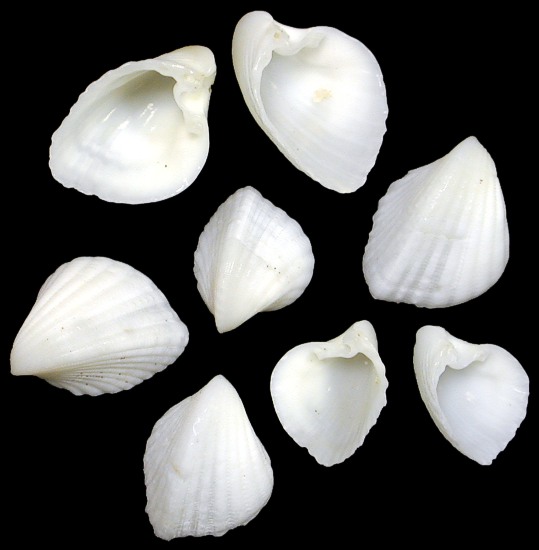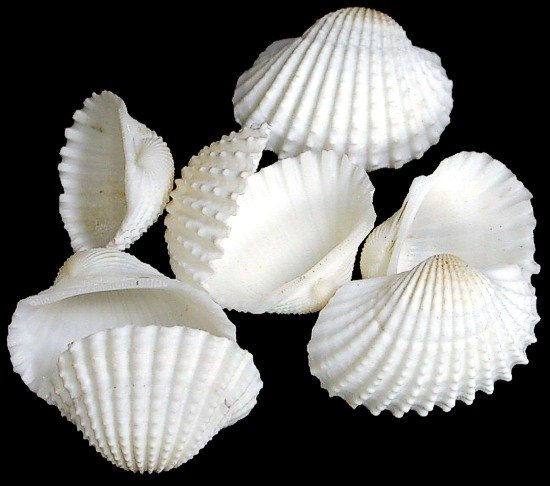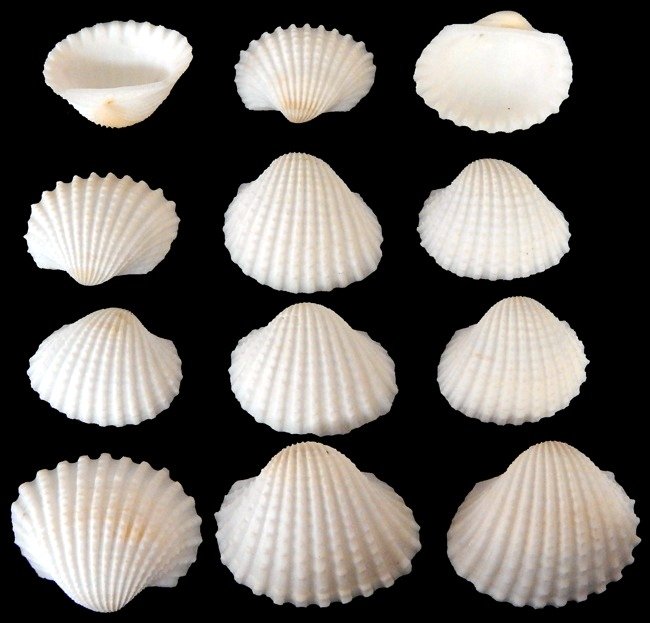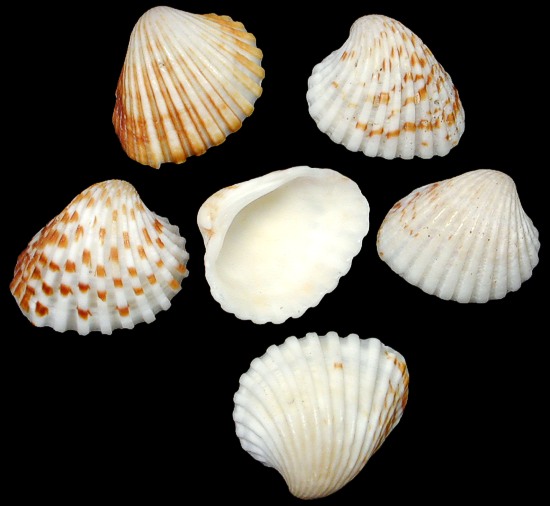As the site is updated, each listing includes the shipping cost. Some listings which I have not updated still give you calculated shipping costs based on weight and size of package. (In the sections I have updated) If you select several different listings, we will consolidate your order and charge you the actual cost of the entire package. The shipping over charge will be refunded to you, when your order is shipped.
HIGH QUALITY ARK SHELLS
Arcidae common name Ark clam
This family of small to large-sized saltwater clams or marine bivalve mollusks; which number around 200 species worldwide vary in shape & size.
The shells of ark clams are often white or cream, but in some species, the shell is either striped, tinted with, or completely colored, a rich brown. Living Ark shells of most species has a top shell layer that is thick brown periostracum affixed to the harder calcareous part of the shell. Species such as Barbatia, the outer horny covering is tufted at the end of the shell into something that resembles a beard, hence the name Barbatia or bearded one.
The periostracum is a thin, organic coating (or "skin") that is the outermost layer of the shell of many shelled animals, including mollusks and brachiopods. Among mollusks, it is primarily seen in snails and clams. The periostracum is an integral part of the shell, and it forms as the shell forms, along with the other shell layers. The periostracum is used to protect the organism from corrosion.
The Arca species part of the family of Ark shells has a large flat area between the umbones which, in an undamaged shell, somewhat resembles a deck, with the rest of the shell perhaps illustrating an ancient wooden boat such as Noah's ark, hence the common name Ark shells.
umbone, (umbo) is part of each valve of the bivalve shell or univalve mollusk. It usually contains the valve's beak, the oldest point of the valve, and its degree of prominence and position relative to the hinge line are sometimes helpful in distinguishing bivalve taxa. The umbo forms while the animal is a juvenile, and radial growth subsequently proceeds around that area. The umbo is situated above the hinge line. In those bivalves where the umbones do not protrude, as is the case for example in some mussels, the umbones can nonetheless usually be readily identified by examining the concentric growth lines of the shell.
(REF: Brink, Laura A. "Mollusca: Bivalva". University of Oregon) (REF: "Advanced glossary of molluscan terms | The Conchological Society of Great Britain and Ireland". www.conchsoc.org. The Conchological Society of Great Britain and Ireland)
bivalve, (class Bivalvia), any of more than 15,000 species of clams, oysters, mussels, scallops, and other members of the phylum Mollusca characterized by a shell that is divided from front to back into left and right valves. The valves are connected to one another at a hinge.
All ark shells have a long straight hinge line with a single row of numerous small and unspecialized "teeth". This is known as a "taxodont dentition" and represents an ancient ancestor. This kind of hinge line is also found in the bivalve families Glycymerididae, Nuculidae and Nuculanidae.
The thick outer skin or periostracum of an ark clam can act as camouflage, such that the shells can sometimes look like stones when lying on the bottom.
Large ark clams, such as Arca zebra, are commonly used as bait, as well as food, throughout the Caribbean.
Some ark clams species, such as the blood cockle (Anadara granosa, a.k.a. Tegillarca granosa) are raised in aquaculture
Aquaculture also known as aquafarming, is the controlled cultivation ("farming") of aquatic organisms such as fish, crustaceans, mollusks, algae and other organisms of value such as aquatic plants (e.g. lotus). Aquaculture involves cultivating freshwater, brackish water and saltwater populations under controlled or semi-natural conditions, and can be contrasted with commercial fishing, which is the harvesting of wild fish. Mariculture, commonly known as marine farming, refers specifically to aquaculture practiced in seawater habitats and lagoons, as opposed to freshwater aquaculture. Pisciculture is a type of aquaculture that consists of fish farming to obtain fish products as food.
Aquaculture can also be defined as the breeding, growing, and harvesting of fish and other aquatic plants, also known as farming in water. It is an environmental source of food and commercial product which help to improve healthier habitats and used to reconstruct population of endangered aquatic species. Technology has increased the growth of fish in coastal marine waters and open oceans due to the increased demand for sea food.
Aquaculture can be conducted in completely artificial facilities built on land (onshore aquaculture), as in the case of fish tank, ponds, aquaponics or raceways, where the living conditions rely on human control such as water quality (oxygen), feed, temperature. Alternatively, they can be conducted on well-sheltered shallow waters nearshore of a body of water (inshore aquaculture), where the cultivated species are subjected to a relatively more naturalistic environments; or on fenced/enclosed sections of open water away from the shore (offshore aquaculture), where the species are either cultured in cages, racks or bags, and are exposed to more diverse natural conditions such as water currents (such as ocean currents), diel vertical migration and nutrient cycles.
According to the Food and Agriculture Organization (FAO), aquaculture "is understood to mean the farming of aquatic organisms including fish, mollusks, crustaceans and aquatic plants. Farming implies some form of intervention in the rearing process to enhance production, such as regular stocking, feeding, protection from predators, etc. Farming also implies individual or corporate ownership of the stock being cultivated." The reported output from global aquaculture operations in 2019 was over 120 million (tonnes equals 2,204.6 pounds) valued at US $274 billion. However, there are issues with the reliability of the reported figures. Further, in current aquaculture practice, products from several kilograms of wild fish are used to produce one kilogram of a piscivorous fish like salmon. Plant and insect-based feeds are also being developed to help reduce wild fish being used for aquaculture feed.
Particular kinds of aquaculture include fish farming, shrimp farming, oyster farming, mariculture, pisciculture, algaculture (such as seaweed farming), and the cultivation of ornamental fish. Particular methods include aquaponics and integrated multi-trophic aquaculture, both of which integrate fish farming and aquatic plant farming.
(REF: US Department of Commerce, National Oceanic and Atmospheric Administration. "What is aquaculture?") (REF:Global Aquaculture Production Fishery Statistical Collections ) (REF:FAO FIGIS Database (2022) Global Aquaculture Production 1950-2019 ) (REF: Watson, Reg; Pauly, Daniel (2001). "Systematic distortions in world Fisheries catch trends". Nature. 414 ) (REF: FAO's work on climate change Fisheries & aquaculture 2019 (PDF). Food and Agriculture Organization. 2019)
Scientific classification
Domain: Eukaryota
Kingdom: Animalia
Phylum: Mollusca
Class: Bivalvia
Order: Arcida
Super family: Arcoidea
Family: Arcidae
Lamarck, 1809

NATURAL ARK SHELL
K1-8
A quarter pound of hand-selected Natural Ark shells measuring between 1/2 and 1 inch. .... $6.35


WHITE ARK SHELL
NS-8
One ounce of hand-picked White Ark Shells, measuring less than 3/4 inch....... $4.65
N0-8
One quarter pound of hand-picked White Ark Shells, measuring between 3/4 and 1 inch.......OUT OF STOCK
N1-2-8
One quarter pound of hand-selected White Ark Shells, measuring between 1 and 1 3/4 inches......$5.59
N3-8
One quarter pound of handpicked White Ark shells, ranging in size from 1.75 to 2.5 inches...... $5.79

BROWN and WHITE ARKS
MM1-8
A quarter pound of handpicked Brown and White Ark shells, available in assorted colors, measuring between 3/4 and 1 inch....... $5.59